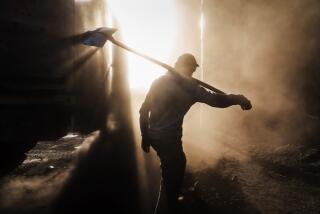U.S. Raids Afghan Site, Seizes 27 Taliban Fighters
- Share via
WASHINGTON — U.S. soldiers captured 27 Taliban fighters Thursday in a predawn raid north of the Afghan city of Kandahar that left one Green Beret injured and 15 Taliban holdouts dead, in the campaign’s first hostile action reported by the Pentagon in two weeks.
The intense firefight highlighted the continued aggressive search by U.S. special operations troops for pockets of Taliban and Al Qaeda resistance throughout Afghanistan.
The Army Special Forces soldier was hit in the ankle during a skirmish that began when the U.S. troops attacked a building suspected of housing Taliban or Al Qaeda leaders in the mountains 40 miles north of Kandahar, the southern city that gave rise to the now-deposed Taliban regime. Intelligence operatives had been monitoring the fighters, mostly Afghans who probably “are not simply foot soldiers,” Defense Secretary Donald H. Rumsfeld said.
Pentagon strategists continue to target groups of armed pro-Taliban troops throughout Afghanistan, seeking to capture them alive in order to interrogate them about the Al Qaeda network and the whereabouts of Osama bin Laden and other fugitives, said Gen. Richard B. Myers, chairman of the Joint Chiefs of Staff.
Operating alone or with Afghan or other coalition forces, U.S. troops will “continue for some period of time” trailing dangerous, sometimes large groups that remain largely confined to narrow, mountainous regions, Rumsfeld said.
“There are a lot more of these pockets,” Rumsfeld said. “We are going to pursue them. We are pursuing them now. We pursue them alone. We pursue them with coalition forces. We pursue them with Afghan forces. And we’re going to keep at them until we get them.”
Tracking down the elusive Taliban and Al Qaeda holdouts is likely to keep U.S. forces in the Central Asian nation in significant numbers, he said.
“That takes presence. You can’t do that from Chicago,” Rumsfeld said.
Rumsfeld also suggested that another priority, helping to stabilize the country as the interim Afghan government undertakes its six-month tenure, is likely to keep U.S. forces in Afghanistan through at least the summer.
“We do feel--certainly the president of the United States feels and the members of his government feel--that we want to do what is appropriate for us to do to help them to get through what is clearly a difficult period,” he said.
To further that aim, the Treasury Department said Thursday that it had authorized the Federal Reserve to release about $217 million in Afghan Central Bank assets. The assets, including $193 million in gold, had been frozen under a 1999 order that blocked all assets of the Taliban regime.
“These funds will now be available to help stabilize the Afghan economy, strengthen the operations of the Central Bank and shape a better future for the people of Afghanistan,” Treasury Secretary Paul H. O’Neill said.
The injured American, whose name was withheld pending notification of relatives, was taken to a nearby hospital and was in stable condition Thursday. Soldiers who cleared the site after the raid destroyed a large cache of weapons and ammunition, defense officials said. The captured prisoners were moved to Kandahar for further questioning.
The special operations soldiers work separately from the 3,600 U.S. Army and Marine Corps troops stationed at Kandahar’s airport. Nevertheless, Army spokesman Ignatius Perez told reporters at the airport, security there was increased after the Thursday raid.
The last major clash between holdouts and U.S. forces came at the airport about two weeks ago on the night the first group of detainees from the Afghan campaign was being transported from a detention camp there to a U.S. naval base at Guantanamo Bay, Cuba.
In an effort to keep intelligence out of enemy hands, U.S. warplanes Thursday dropped two precision-guided bombs on a helicopter that crashed in Afghanistan over the weekend, killing two Marines and injuring five. Troops usually retrieve downed planes and helicopters, but the mountainous terrain prevented that, Myers said.
As fighting continued in Afghanistan, warplanes struck another front. After reports that coalition planes had been fired upon by surface-to-air and other missiles while patrolling in the “no-fly” zone of southern Iraq, bombers from the U.S.-led Operation Southern Watch struck radar and other sites in Iraq on Monday, Wednesday and Thursday, Myers said.
The last coalition strikes in Iraq hit antiaircraft artillery sites Dec. 27. Thursday’s bombing came after the latest of more than 630 incidents of Iraqi surface-to-air missile and antiaircraft artillery fire directed against coalition pilots since December 1998, the Pentagon said. Iraqi aircraft violated the no-fly zone more than 150 times during the same period, defense officials said.
*
Times staff writer Tyler Marshall in Kandahar contributed to this report.
More to Read
Sign up for Essential California
The most important California stories and recommendations in your inbox every morning.
You may occasionally receive promotional content from the Los Angeles Times.










